
Our trip beg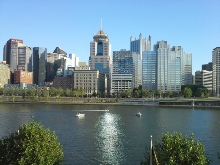 an not as a cross-
an not as a cross-
T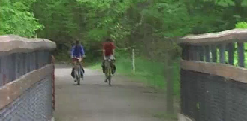 he first leg of the trail is the 150 mile Great Allegany Passage (GAP) trail from Pittsburgh to Cumberland, MD. The GAP trail is a rails-
he first leg of the trail is the 150 mile Great Allegany Passage (GAP) trail from Pittsburgh to Cumberland, MD. The GAP trail is a rails-
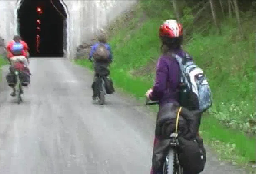 The trail was in fantastic shape and ideal for biking. Since the trail is over an old railroad right of way, the grade is very slight, and before you know it you’ve climbed the Allegany range to the Continental Divide and are ready to descend into the Chesapeake valley to Washington D.C. (But if you try the trail from East to West be ready for a wicked climb from Cumberland to the Continental Divide.) You’ll also encounter several tunnels along the way including the one-
The trail was in fantastic shape and ideal for biking. Since the trail is over an old railroad right of way, the grade is very slight, and before you know it you’ve climbed the Allegany range to the Continental Divide and are ready to descend into the Chesapeake valley to Washington D.C. (But if you try the trail from East to West be ready for a wicked climb from Cumberland to the Continental Divide.) You’ll also encounter several tunnels along the way including the one-
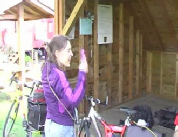 Campsites are readily available along the trail, but as a rule not on the trail -
Campsites are readily available along the trail, but as a rule not on the trail -
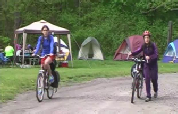 We were very well received at Yough Lake Campground in Confluence, OH, where the owner-
We were very well received at Yough Lake Campground in Confluence, OH, where the owner-
price of a campsite!
A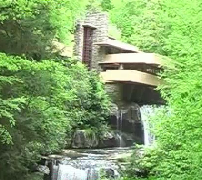 nother fun adventure along the way was a stop at Ohiopyle State Park, right along the trail -
nother fun adventure along the way was a stop at Ohiopyle State Park, right along the trail -
W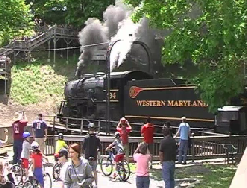 hen you reach the Continental Divide, you’re also at the Mason-
hen you reach the Continental Divide, you’re also at the Mason-
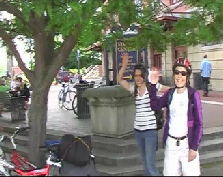 When you finally reach Cumberland, visit the welcome center to celebrate your accomplishment of crossing what used to be the great barrier between the Potomac and Ohio River valleys, and the main obstacle to westward expansion. Cumberland is a very picturesque, historic, but unfortunately somewhat impoverished town on the Potomac River, and marks the endpoint of the famous C & O canal -
When you finally reach Cumberland, visit the welcome center to celebrate your accomplishment of crossing what used to be the great barrier between the Potomac and Ohio River valleys, and the main obstacle to westward expansion. Cumberland is a very picturesque, historic, but unfortunately somewhat impoverished town on the Potomac River, and marks the endpoint of the famous C & O canal -
T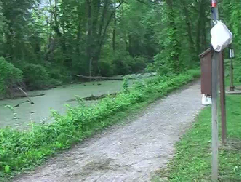 he canal channel is mostly intact, but only in places is still
he canal channel is mostly intact, but only in places is still
flooded with water. The foot path where the mules would
pull the barges going up river is now the 185 mile C & O
bike path from Cumberland to D.C., which is rather rough
and muddy in spots, but passable. You won’t make as good
time as on the GAP trail, but probably better than the mules
did. Big plus: it has numerous primitive campsites along the
way. On the other side of the canal channel you can see the
B & O rail line, which still runs, and which eventually put
the C & O canal out of business.
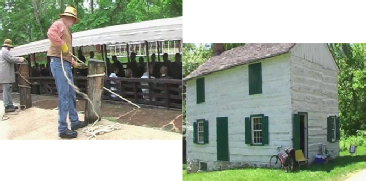 The history here is fascinating, with a number of locks and viaducts from the old canal system visible along the way in varying degrees of disrepair. There is one lock still in working order where demonstrations of barge transport are held. Many of the houses built for the lock workers and their families still stand, and one is a museum with artifacts of the time.
The history here is fascinating, with a number of locks and viaducts from the old canal system visible along the way in varying degrees of disrepair. There is one lock still in working order where demonstrations of barge transport are held. Many of the houses built for the lock workers and their families still stand, and one is a museum with artifacts of the time.
Another fascinating spot along the trail is H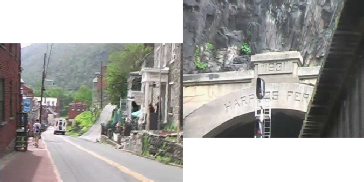 arper’s
arper’s
Ferry, WV, where arguably the primer bike trail in
America, the GAP/C & O trail, meets the primer
hiking trail in America, the Appalachian trail.
Here also merge two great rivers: the Potomac
and the Shenandoah. Harper’s Ferry was also
the location of the U.S. Armory for many years,
which John Brown invaded to try to spark the
Civil War, but was defeated.
As 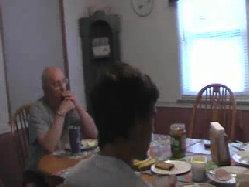 you approach D.C., you pass not far from Antietam battlefield, the site of the bloodiest battle during the Civil War. A very sobering experience. But our reflections on our visit were short lived when we realized that we took the wrong road back to the trail and ended up lost and riding through a thunderstorm. Some wonderful people learned of our plight when we stopped for directions, and since it was late in the day, they invited us into their home to dry off, feast up, sleep in real beds, and even wash clothes. It was a true God send.
you approach D.C., you pass not far from Antietam battlefield, the site of the bloodiest battle during the Civil War. A very sobering experience. But our reflections on our visit were short lived when we realized that we took the wrong road back to the trail and ended up lost and riding through a thunderstorm. Some wonderful people learned of our plight when we stopped for directions, and since it was late in the day, they invited us into their home to dry off, feast up, sleep in real beds, and even wash clothes. It was a true God send.
W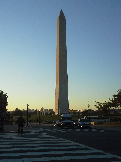 ell, at last we rolled into D.C., the nation’s capital, which I won’t have to describe to you. We camped at Greenbelt National Park, a wooded area located, believe it or not, right in the D.C. Metropolitan area, until Matthew could get settled into his place in College Park.
ell, at last we rolled into D.C., the nation’s capital, which I won’t have to describe to you. We camped at Greenbelt National Park, a wooded area located, believe it or not, right in the D.C. Metropolitan area, until Matthew could get settled into his place in College Park.
Segment 1 of what would become, although we didn’t know it at the
time, a cross country adventure was complete.